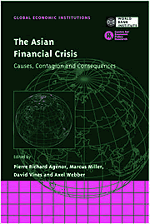Book contents
- Frontmatter
- Contents
- List of figures
- List of tables
- Preface
- List of conference participants
- Acknowledgements
- List of abbreviations and acronyms
- Introduction
- Part One General Accounts
- Part Two Theoretical Contributions
- Part Three Contagion
- Part Four Policy Responses
- 11 Coping with crises: is there a ‘silver bullet’?
- 12 Must financial crises be this frequent and this painful?
- 13 Round Table discussion
- Index
12 - Must financial crises be this frequent and this painful?
from Part Four - Policy Responses
Published online by Cambridge University Press: 26 February 2010
- Frontmatter
- Contents
- List of figures
- List of tables
- Preface
- List of conference participants
- Acknowledgements
- List of abbreviations and acronyms
- Introduction
- Part One General Accounts
- Part Two Theoretical Contributions
- Part Three Contagion
- Part Four Policy Responses
- 11 Coping with crises: is there a ‘silver bullet’?
- 12 Must financial crises be this frequent and this painful?
- 13 Round Table discussion
- Index
Summary
The evidence that crises are frequent and painful
Must financial crises be this frequent and this painful? Before discussing some of the considerations that go into answering this question, I first want to document my claim that they are frequent and painful. Clearly anyone watching the world from mid-1997 to late 1998 would be left with little doubt that financial crises can be very severe. But the East Asian crisis is only the latest in a series of spectacular economic catastrophes in developing countries. In the last 20 years there have been at least 10 countries that have suffered from the simultaneous onset of a currency crisis and a banking crisis. The result has been full-blown economic crises causing, in many cases, GDP contractions of 5–12 per cent in the first year of the crisis, and negative or only slightly positive growth for several years after. Many other countries have witnessed contractions of similar magnitude following currency or banking crises.
Financial crises are not strictly exogenous and in many cases the slow down itself, or the same factors that led to it, also helped cause the financial crisis. But there is no doubt that the over-shooting of exchange rates, the withdrawal of foreign capital, the non-rollover of short-term debts, the internal credit crunches, the process of disintermediation and many of the other characteristics of external and internal crises played a large role in these collapses.
Crises are also becoming increasingly frequent, at least relative to the post-Second World War period. We have had, in Caprio's memorable phrase, ‘a boom in bust[s]’ (Caprio, 1997, p. 80).
- Type
- Chapter
- Information
- The Asian Financial CrisisCauses, Contagion and Consequences, pp. 386 - 403Publisher: Cambridge University PressPrint publication year: 1999
- 14
- Cited by



